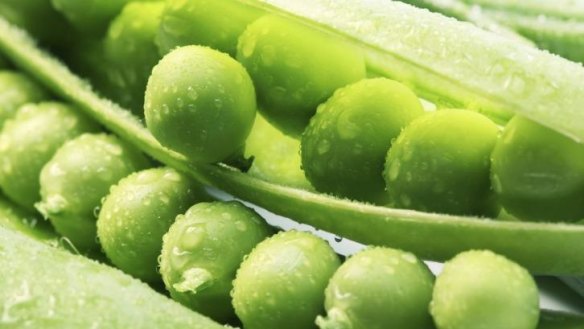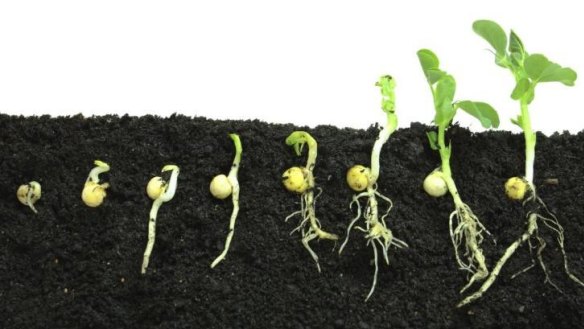How to grow winter peas in Canberra

Using the whole garden throughout the year to produce crops is a very desirable goal for home gardeners. Winter peas can contribute well to this goal and they will brighten up your backyard as well as your kitchen. The beautiful flowers against the backdrop of the fast growing, light green tendrils and branches of the plants will give you a lift in those cold days of August and September.
There are few growing requirements for peas. They just need well-drained soils, not too rich. They produce their own nitrogen supplies so are best planted into garden beds where you had heavy feeders growing over the summer months. We have planted our winter peas where we had been growing sweet corn. We have also planted into the beds that had grown tomatoes, for crop rotation purposes.
Just dig in some well finished compost and hill up the garden bed to be 7-10 centimetres above the surrounding land. You can add in a little potash if you think the soil is a little on the acidic side; this will also help the plants to toughen up in the winter months and helps with flowering.

Plant the seeds to a depth of 5cm and space them 7-8 centimetres apart. Allow 80-90 centimetres between rows. When you plant out the seed, water only once to avoid the seeds rotting from too much moisture.
Sugar snap peas are wonderfully delicious and easy to grow. You can eat the whole pod, picking them when they are filled with sweetness but not too big. Snow peas will also grow well in the Canberra region, providing you with many food options, to use in salads, gently steamed to serve as a vegetable or added to Asian stir fry dishes.
Shelling peas are the principal ingredient of the famous petits pois dish of France. As with the smaller cousins, your final harvest can be increased markedly by regular harvesting. Production of the flowering nodes is encouraged by the harvesting of the early maturing pods.
To effectively grow peas you will need to invest in some supplies of mesh. Sections of reinforcing mesh, perhaps 2.5 metres long and 1.5 metres high, can be used for many years to grow peas in the winter and cucumbers in the summer.
Most snow peas varieties are climbing plants so you will need to install a trellis at time of planting, or soon afterwards. Snow peas will take eight to 10 weeks to produce a good harvest. The art in planting is to arrive at the flowering times when the likelihood of frost has declined, as all pea flowers are susceptible to a heavy frost.
Oregon giant is an excellent choice as it is naturally resistant to the mildew problems that can badly affect pea production. It is a heavy producer of very, sweet, large pods. Melting mammoth is another good climbing variety, growing to two metres, producing beautiful white flowers and pods of12 centimetres.
I have been searching for bush pea varieties to grow in small spaces or in larger garden sections which would otherwise need metres and metres of trellising. I have already dedicated to our earlier plantings of snow peas. I am sure that many home gardeners will have smaller plots sometimes, where a large section of mesh will not fit.
Sugar ann is one of the sweetest sugarsnap peas. It is very productive and grows as a bush plant to around 60 centimetres in height. It is fast growing and will produce a crop in two months. You could adopt some succession plantings to enjoy a prolonged springtime harvest.
Greenfeast is the best bush type shelling pea to grow. It is disease resistant and a hardy variety for the colder winter months. Like other varieties, the seeds will germinate within eight to 14 days, depending on the temperature of the soil and daytime seasonal conditions. It will bear for quite a long period, over four or five weeks.
Oregon sugar is a good bush type snow pea. It produced pods to 10 -11 centimetres which are crisp yet tender and full of flavour. It will produce a good crop in eight to nine weeks, if frosts do not kill off the first flowers.
May the sun shine often this winter as you go about producing fresh and healthy foods from your own garden.
Peas with onions and lettuce
(an old French dish from the times when lettuces were usually cooked)
50gm butter
16 small onions or shallots
500gm fresh peas, shelled
250gm iceberg lettuce, finely shredded
2 parsley sprigs
1 tsp castor sugar
125ml chicken stock
1 tbsp plain flour
salt and pepper
Melt 30 grams of the butter into a large saucepan then add the onions and cook for one minute, stirring continuously. Add in the peas, the shredded lettuce, sprigs of parsley and sugar. Add the chicken stock and stir in well. Cover and cook over a moderately low heat for 15 minutes until the onions are cooked throughout. Remove the parsley sprigs. Mix the remaining butter with the flour to make a smooth paste. Add in small amounts to the pot of vegetables, stirring well, until the juices thicken. Season with a little salt and freshly ground pepper.
Recipe from A Taste of France cookbook
This week in the garden
- Plant out advanced onion, shallot and leek seedlings.
- Dig well-rotted compost into fallow garden beds or plant green manure crops to lift the humus content over winter.
- Plant strawberry runners into enriched, hilled up rows of soil. Make the rows wide enough to take two plants and plant 15 cm apart.
- Consider buying and planting a row of raspberries or brambleberries. They grow well next to a back fence where you can set up support for the canes.
- Check existing rhubarb plants to see if they are well advanced. Divide and plant the sets into enriched soil.
- When pruning fruit trees, remove all broken and dead branches, then trim for height and thin out where the spurs are very crowded or overlapping.
Owen Pidgeon runs the Loriendale Organic Orchard near Hall.
Restaurant reviews, news and the hottest openings served to your inbox.
Sign up